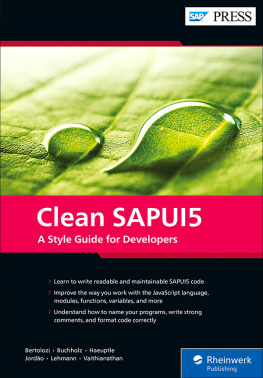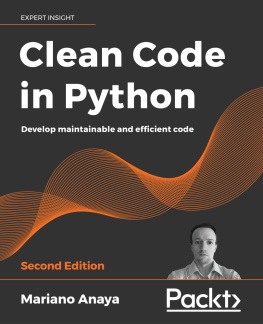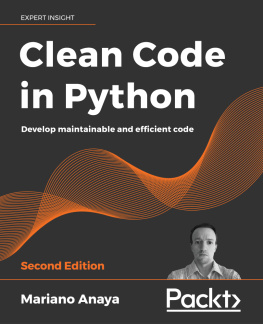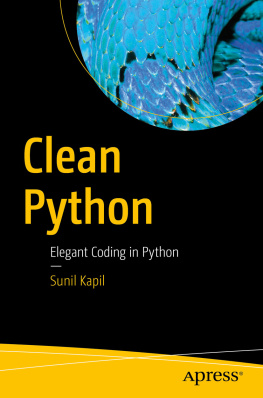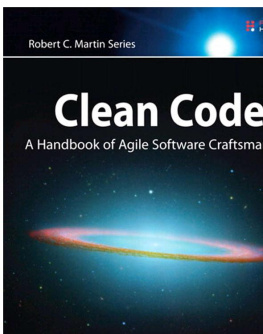Clean Code
Advanced Guide to Learn the Realms of Clean Code from A-Z
Copyright 2020 - All rights reserved.
The content contained within this book may not be reproduced, duplicated or transmitted without direct written permission from the author or the publisher.
Under no circumstances will any blame or legal responsibility be held against the publisher, or author, for any damages, reparation, or monetary loss due to the information contained within this book, either directly or indirectly.
Legal Notice:
This book is copyright protected. It is only for personal use. You cannot amend, distribute, sell, use, quote or paraphrase any part, or the content within this book, without the consent of the author or publisher.
Disclaimer Notice:
Please note the information contained within this document is for educational and entertainment purposes only. All effort has been executed to present accurate, up to date, reliable, complete information. No warranties of any kind are declared or implied. Readers acknowledge that the author is not engaging in the rendering of legal, financial, medical or professional advice. The content within this book has been derived from various sources. Please consult a licensed professional before attempting any techniques outlined in this book.
By reading this document, the reader agrees that under no circumstances is the author responsible for any losses, direct or indirect, that are incurred as a result of the use of information contained within this document, including, but not limited to, errors, omissions, or inaccuracies.
Table of Contents
Table of Contents
Introduction
Chapter 1: Introduction to Clean Code
What is a Clean Code?
Merits of Clean Code
Code Formatting and Its Role
Uniform Coding Style
Documentation of the Code
Configuration of Tools
Synopsis
Chapter 2: Idioms in Python
Understanding of Indices and Slices
Using Context Managers
Underscore Conventions in Python
Making Objects That Can Iterate
Chapter 3: Characteristics of Good and Clean Code
Common Characteristics of Great Code
The Defensive Programming Code Design
Techniques for Error Handling
Understanding the Concept of Separation of Concerns
Some Useful Programming Acronyms
Inheritance
Multiple Inheritance
Chapter 4: The Principles of Clean Software Code
The Single Responsibility Principle
The Open/Closed Principle
A Software Code Without the Open and Closed Principle
Making the Code Extensible
Liskovs Substitution Principle
Using Mypy to Identify Erroneous Datatypes in Method Signatures
Using the Pylint Tool to Identify Incompatible Signatures
The Interface Segregation Principle
The Dependency Inversion Principle
Chapter 5: Implementing the Decorators to Improve the Quality of the Code
Decorators in Python
Working with Functions to Implement Decorators
Working with Decorator Classes
Providing Parameters to Decorators
Understanding the Implementation of Decorators in Terms of Nested Functions
Implementing Decorators Effectively and Avoiding Implementation Mistakes
Chapter 6: Using Python Generators When Coding
The Purpose of Generators
Understanding the Use of Generators
Using Idioms to Perform Iterations
Conclusion
References
Introduction
If we talk about the fundamental or core discipline which the very foundation of this book revolves around, it would undoubtedly be the principles taught in software engineering. In a sense, keeping the code clean, making it more robust, removing its fragility, and making the entire software overall more artistic is what software engineers actually do, but exploring the realm of software engineering can easily confuse your path and blind you from your goal. Thus, such topics require a guiding hand, and without one, theres no guarantee that what you learn will actually be useful.
This is the core concept of this book, to be a guiding hand in learning those techniques of software engineering that can help us create clean code. Before we jump into the first chapter, a piece of advice is to correct your state of mind. To elaborate, you need to define the perspective through which you will read this book. Usually, many people read books such as this with the mindset that it will have the one and only solution to a problem they couldnt find anywhere else. This psychology is based on nothing more than a misconception because there is no perfect solution to a problem in software engineering.
Moreover, if you encounter a problem, only you can come up with the solution, thats how the problems in the programming world have been solved to this day, and this also how new innovations are made.
So, this book will serve as a guiding hand for you, making you explore those topics that are the most crucial for you to develop a robust understanding of programming and thus, help you achieve the goal of this book, to be able to clean any code you want, whenever you want and to come up with your own solutions to any dead ends you might encounter in programming.
Chapter 1: Introduction to Clean Code
This chapter will focus on the question and necessity of clean code, and we will learn everything there is to know about what a clean code is and why it is necessary. This chapter focuses on understanding that a code quality amounts to the code being readable and relaxes an individual from extensive rework when tracing and rectifying an error.
In addition to this, we will also learn the importance of formatting and documenting the code. This might sound like unnecessary or useless work, but we will see the role that formatting and documenting the code plays when it comes to maintainability and accessibility of the work.
Overall, we will learn the proper rules and guidelines that would improve our codes' efficiency and effectiveness. Automated tools have made coders and programmers' lives easier due to the minimum human interaction involved in their tests. Therefore, it is essential to understand the use of these automated tools in maintaining the code in line with the reference. We will shortly discuss the method of enacting and embedding the tools in the codes to run as part of the code itself.
By the end of this chapter, we will have the answers relating to the queries about the meaning, use and importance of a clean code, its impact on our work, and the use of automated tools in the code itself. The information gained through this should be used in creating a clean and automated code practically.
In summary, the following points would be resolved at the end of this chapter:
Importance of a clean code.
Identical and maintainable software construction.
Using features of Python for self-documentation of the code.
Configuration of automated tools that will provide help in the layout of the code.
The use of automated tools to detect the problem and error at the first instance.
What is a Clean Code?
To understand a clean code, an individual must have some experience relating to creating or checking the codes. This is because a clean code is not a thing that can be detected by any compilers or machines. There is no definition or rules regarding the creation and use of a clean code. The code, no matter how badly written, will not affect the machine. But only the professional eye can catch the irregularities in a badly written and formatted code.









